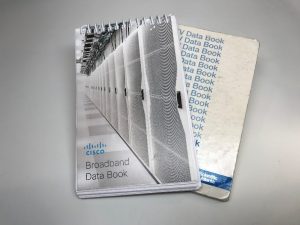The cable broadband access network is extremely complex. Hybrid fiber/coax (HFC), fiber-to-the-[feeder, building, curb, home, premises, tap], passive optical networks (PONs), digital video, DOCSIS®, remote PHY, quadrature amplitude modulation (QAM), orthogonal frequency division multiplexing (OFDM) – all of these technologies have their own technical information. And, for broadband cable technologists to be effective in their jobs, they need lots of information at their fingertips.
Let’s say you’re out in the field performing leakage measurements on CTA Channel 17 (yes, they’re called CTA channels now; the old EIA designation was deprecated years ago) and need to know the signal level at a dipole antenna’s terminals when the field strength is 50 microvolts per meter (µV/m). The answer is in the guide. Can’t remember the through-loss of a 12 dB directional coupler at 750 MHz? It’s in the guide. Want to convert that optical receiver’s -2 dBm input power to a value in milliwatts? The answer’s in the guide. Forgot the center frequency of CTA Channel 116? It’s in the guide. Trying to figure out the weight in pounds of that box labeled in kilograms? The conversion factor is in the guide. Taking an open-book test for your job, and forgot the free-space value of the speed of light in meters per second? That’s in the guide, too.
And, for those back in the office, no one likes being caught in a plant design review meeting not knowing the attenuation-versus-frequency of various sizes of coaxial cable and insertion loss of distribution passives for a quick spot check of the new prints. The guide is your friend. I’m guessing it has been a while since you calculated non-linear distortions in a cascade of active devices without the benefit of a spreadsheet. The formulas for that and answers to much more are in the guide.
For many years, Cisco has recognized these needs by creating and keeping up-to-date a handy reference book intended to be used as a quick-reference source for topics related to broadband network technology.
This pocket-size reference guide is popular with installers, technicians, engineers, and others; we gave away thousands and were constantly being asked for more. It’s hard to beat the convenience of a treasure-trove of comprehensive technical information in one place. As a printed spiral-bound book, users would toss it in their trucks, go-bags, and desks. The easy to use flipbook format was a winner.
Given the current environment, we thought we’d make our latest version– the Cisco Broadband Data Book – Revision 21, published in August of 2019 available in an eGuide format.
That link will take you to near the bottom of Cisco’s Cable Network Transformation web page, where you’ll see the section “More Cable Network Resources.” Scroll over to the right and click on “Cisco Broadband Data Book.” That will bring up a downloadable electronic (PDF) version of the Cisco Broadband Data Book, Rev. 21 (217 pages!). Within the document, you can click on the desired listing in the table of contents to go directly to that section.
I count myself among the fans of these gems and still have a handful of older technical reference guides from a variety of manufacturers; some date back to the late 1960s and early ’70s! That collection used to be larger, but I donated part of it to The Cable Center in Denver, Colorado, which maintains an extensive collection of cable industry pocket-size reference guides in the Barco Library and Edward D. Breen Technical Archives.
 I hope you find Rev. 21 to be a useful resource. The accompanying photo shows a printed copy of Rev. 21 (left) that was handed out at Cable-Tec Expo 2019, and my well-worn copy of Rev. 7, Scientific Atlanta’s CATV Data Book from December 1990. If you have a copy of an even older version than Rev. 7, drop me a note!
I hope you find Rev. 21 to be a useful resource. The accompanying photo shows a printed copy of Rev. 21 (left) that was handed out at Cable-Tec Expo 2019, and my well-worn copy of Rev. 7, Scientific Atlanta’s CATV Data Book from December 1990. If you have a copy of an even older version than Rev. 7, drop me a note!

CONNECT WITH US